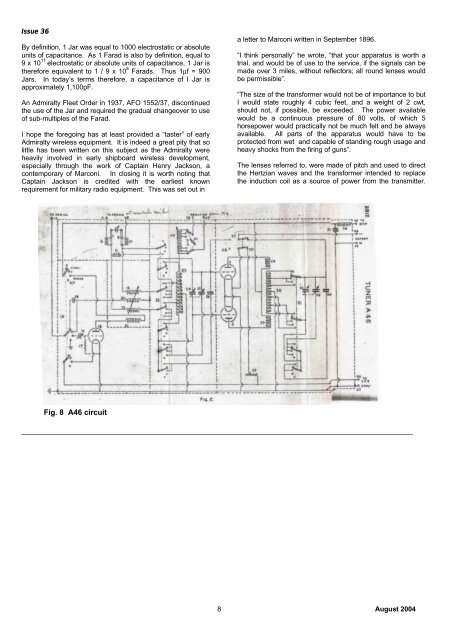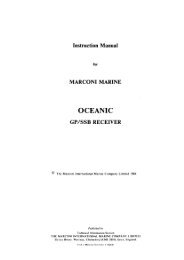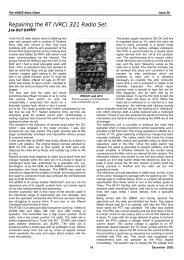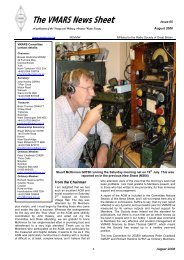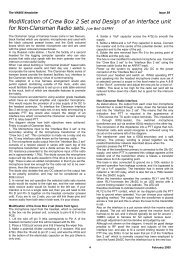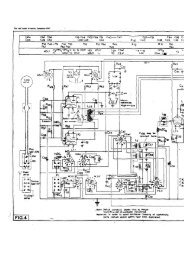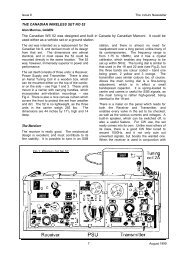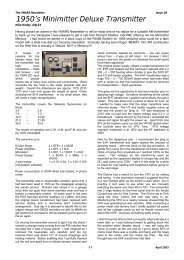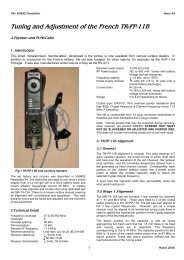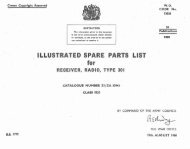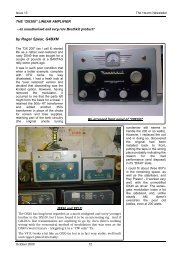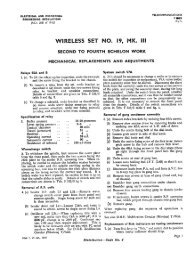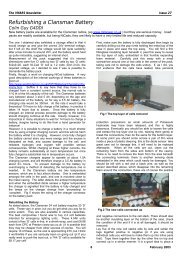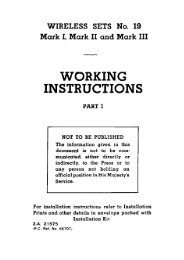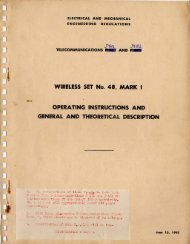Some Early Admiralty Wireless Equipment - VMARSmanuals
Some Early Admiralty Wireless Equipment - VMARSmanuals
Some Early Admiralty Wireless Equipment - VMARSmanuals
Create successful ePaper yourself
Turn your PDF publications into a flip-book with our unique Google optimized e-Paper software.
Issue 36<br />
By definition, 1 Jar was equal to 1000 electrostatic or absolute<br />
units of capacitance. As 1 Farad is also by definition, equal to<br />
9 x 10 11 electrostatic or absolute units of capacitance, 1 Jar is<br />
therefore equivalent to 1 / 9 x 10 8 Farads. Thus 1µf = 900<br />
Jars. In today’s terms therefore, a capacitance of I Jar is<br />
approximately 1,100pF.<br />
An <strong>Admiralty</strong> Fleet Order in 1937, AFO 1552/37, discontinued<br />
the use of the Jar and required the gradual changeover to use<br />
of sub-multiples of the Farad.<br />
I hope the foregoing has at least provided a “taster” of early<br />
<strong>Admiralty</strong> wireless equipment. It is indeed a great pity that so<br />
little has been written on this subject as the <strong>Admiralty</strong> were<br />
heavily involved in early shipboard wireless development,<br />
especially through the work of Captain Henry Jackson, a<br />
contemporary of Marconi. In closing it is worth noting that<br />
Captain Jackson is credited with the earliest known<br />
requirement for military radio equipment. This was set out in<br />
a letter to Marconi written in September 1896.<br />
“I think personally” he wrote, “that your apparatus is worth a<br />
trial, and would be of use to the service, if the signals can be<br />
made over 3 miles, without reflectors; all round lenses would<br />
be permissible”.<br />
“The size of the transformer would not be of importance to but<br />
I would state roughly 4 cubic feet, and a weight of 2 cwt,<br />
should not, if possible, be exceeded. The power available<br />
would be a continuous pressure of 80 volts, of which 5<br />
horsepower would practically not be much felt and be always<br />
available. All parts of the apparatus would have to be<br />
protected from wet and capable of standing rough usage and<br />
heavy shocks from the firing of guns”.<br />
The lenses referred to, were made of pitch and used to direct<br />
the Hertzian waves and the transformer intended to replace<br />
the induction coil as a source of power from the transmitter.<br />
Fig. 8 A46 circuit<br />
______________________________________________________________________________________________________________________<br />
8 August 2004


